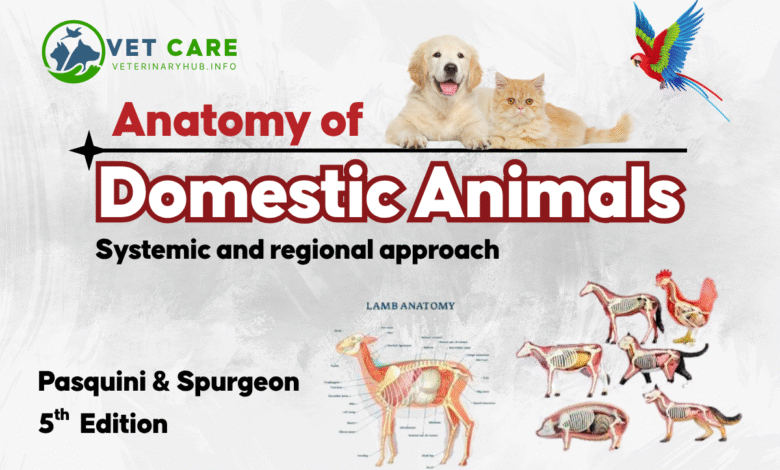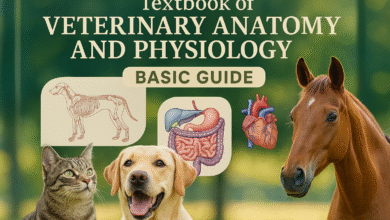Pasquini & Spurgeon Anatomy of Domestic Animals Systemic and regional approach
A Comprehensive Guide to Veterinary Anatomy for Horses, Dogs, Cats, and Livestock

Anatomy of Domestic Animals: Systemic and Regional Approach by Pasquini & Spurgeon is a veterinary anatomy textbook that offers clear illustrations and concise explanations of the anatomical structures of common domestic animals. It uses both systemic and regional approaches, making it ideal for veterinary students and professionals.
👉 Free PDF Download (5th Edition)
Book Description: Anatomy of Domestic Animals: Systemic and Regional Approach by Chris Pasquini, Tom Spurgeon, and Susan Pasquini
Anatomy of Domestic Animals: Systemic and Regional Approach is a highly regarded veterinary anatomy textbook that has served students, educators, and veterinary professionals for decades. Written by Chris Pasquini, Tom Spurgeon, and Susan Pasquini, the book offers a well-balanced combination of detailed anatomical illustrations and concise, practical descriptions. Its dual approach—systemic and regional—makes it a versatile reference tool for understanding the anatomical structure of the most common domestic animals.
This comprehensive text is designed to provide a clear, accessible foundation in veterinary anatomy. It focuses on seven major domestic animal species: the horse, dog, cat, ox (cattle), goat, sheep, and pig. By addressing both systemic anatomy (which examines body systems such as the skeletal, muscular, circulatory, and nervous systems) and regional anatomy (which looks at specific body regions like the head, neck, thorax, and limbs), the book allows readers to understand how different structures function both independently and together within the whole animal.
One of the book’s most distinctive features is its illustrations—over 700 hand-drawn diagrams that are clear, detailed, and specifically created to complement the text. These drawings help students visualize complex anatomical structures without the overwhelming detail that can often be found in photographic images or atlases. Each diagram is labeled and includes brief notes to reinforce key concepts, which enhances memorization and comprehension.
What sets this book apart is its emphasis on comparative anatomy across species. By pointing out differences and similarities in anatomical structures among various animals, the authors help readers appreciate the unique adaptations of each species. This is particularly useful for veterinary students, who must develop diagnostic and surgical skills applicable to a wide range of animals.
Additionally, the text is organized in a way that supports both academic study and clinical application. Every anatomical feature is not only described from a scientific standpoint but also placed in context with its relevance to clinical veterinary practice. This practical focus is one reason the book has remained a favorite in veterinary schools and among practicing veterinarians.
The authors’ experience in veterinary education is evident in the book’s accessible language and layout. Terminology is kept clear and consistent with veterinary standards, making it easier for students and professionals to cross-reference with other academic materials or diagnostic tools.
The book is particularly valuable as a companion to dissection labs and clinical anatomy courses. Because it simplifies complex concepts and supports visual learning, students often find it helpful during examinations and practical assessments. At the same time, it remains a useful reference guide for veterinarians in practice who need a quick refresher on anatomical landmarks or comparative structures.
The 5th edition of Anatomy of Domestic Animals remains widely used, though newer editions or supplemental materials may be available. While some updates to anatomical terminology and educational standards may have occurred since its original publication, the foundational knowledge it provides continues to be relevant and accurate. Many users also appreciate the durable, spiral-bound format (in print editions), which allows for easy use during study sessions or in laboratory environments.
In terms of accessibility, the book is available in both print and digital formats. Several educational websites and veterinary eBook platforms offer free access to the PDF version of the 5th edition, making it a valuable and affordable resource for students around the world.
In conclusion, Anatomy of Domestic Animals: Systemic and Regional Approach is a cornerstone resource for anyone studying or practicing veterinary medicine. Its clear illustrations, structured content, and clinical relevance make it an essential tool for mastering the anatomy of domestic animals. Whether used in the classroom, lab, or clinic, this book remains a trusted guide for developing a strong anatomical foundation.


